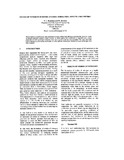| dc.contributor.author | Inambao, F.L. | |
| dc.contributor.author | Mosweu, M. | |
| dc.date.accessioned | 2010-10-20T12:54:40Z | |
| dc.date.available | 2010-10-20T12:54:40Z | |
| dc.date.issued | 2001 | |
| dc.identifier.citation | Inambao, F. L. and Mosweu, M. (2001) Oxide of nitrogen in diesel engines: formation, effects and control, Botswana Journal of Technology, Vol.10,No.2, pp.41-48 | en_US |
| dc.identifier.issn | 1019 1593 | |
| dc.identifier.uri | http://hdl.handle.net/10311/620 | |
| dc.description.abstract | Diesel engines are used in heavy duty applications because of their high effeciency an reliability. However, oxides of nitrogen emissions remain a major concern. In diesel engines, fuel combustion is responsible for a major proportion of oxides of nitrogen emissions. Four sources of the oxides have been identified. The range of possible types of damage to environment and health, as well as effective methods for reduction of oxides of nitrogen, have been analysed. | en_US |
| dc.language.iso | en | en_US |
| dc.publisher | University of Botswana | en_US |
| dc.subject | Diesel engines | en_US |
| dc.subject | Nitrogen emissions | en_US |
| dc.subject | Oxide of nitrogen | en_US |
| dc.title | Oxide of nitrogen in diesel engines: formation, effects and control | en_US |
| dc.type | Published Article | en_US |

